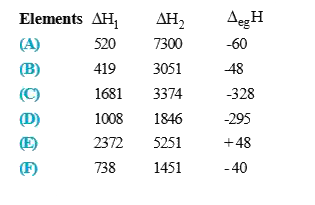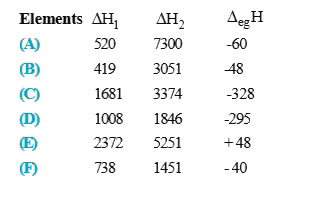Second electron gain enthalpy:
is always negative
is always positive
can be positive or negative
is always zero
The correct Answer is:B
Topper's Solved these Questions
- PERIODIC PROPERTIESBOOK - VK JAISWALCHAPTER - PERIODIC PROPERTIESEXERCISE - Level 2
102 Videos
- PERIODIC PROPERTIESBOOK - VK JAISWALCHAPTER - PERIODIC PROPERTIESEXERCISE - MATCH THE COLUMN
13 Videos
- PERIODIC PROPERTIESBOOK - VK JAISWALCHAPTER - PERIODIC PROPERTIESEXERCISE - SUBJECTIVE PROBLEMS
22 Videos
- p-BLOCK ELEMENTSBOOK - VK JAISWALCHAPTER - p-BLOCK ELEMENTSEXERCISE - SUBJECTIVE PROBLEMS
36 Videos
- QUALITATIVE INORGANIC ANALYSISBOOK - VK JAISWALCHAPTER - QUALITATIVE INORGANIC ANALYSISEXERCISE - SUBJECTIVE PROBLEMS
5 Videos
Similar Questions
Knowledge Check
The second electron gain enthalpies (in kJ mol−1) of oxygen and sulphur respectively are:
A−780,+590B−590,+780C+590,+780D+780,+590The first and second ionization enthalpies and electron gain enthalpy of some elements are as given below:

Which of these elements is the most reactive metal?A(A)B(B)C(F)D(D)The first and second ionization enthalpies and electron gain enthalpy of some elements are as given below:

Which of these elements is the most reactive non-metal?A(C)B(D)C(E)D(F)
The second electron gain enthalpies (in kJ mol−1) of oxygen and sulphur respectively are:
View SolutionFirst and second electrons gains enthalpies of oxygen and −141and+702kJmol−1 . How is large number of oxides accounted for ?
View SolutionThe first and second ionization enthalpies and electron gain enthalpy of some elements are as given below:

Which of these elements is the most reactive metal?
View SolutionThe first and second ionization enthalpies and electron gain enthalpy of some elements are as given below:

Which of these elements is the most reactive non-metal?
View SolutionThe first and second ionization enthalpies and electron gain enthalpy of some elements are as given below:

Which of these elements is the least reactive non-metal?
View Solution
